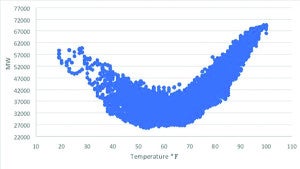ERCOT
-
Commentary
Texas’ Impending Reliability Issues With Wind Power
COMMENTARY Texas has the most wind capacity of any state, generating about 16% of its electricity from wind. In August, as temperatures rose above 100F and consumers increased their use of air conditioning, Texas’ grid operators struggled to meet the record demand for electricity. Many of the wind turbines could not operate because the wind […]
Tagged in: -
Markets
The EU’s Power Provisions: Is Texas a Reliable Indicator?
What does the 21st century power market look like? That is the question the European Union (EU) is attempting to answer with the new electricity regulation and revised electricity directive passed at the end
-
News
EIA: Gas, Renewables Outpacing Coal for Power Generation
The percentage of coal-fired generation in the U.S. electricity mix will continue to decline, the Energy Information Administration (EIA) said May 9, with gas-fired generation accounting for at least 40% of the nation’s power this summer and output from renewables continuing to rise. EIA’s latest Short-Term Energy Outlook (STEO) said coal-fired units will produce only […]
-
News
ERCOT Warns of Summer Emergency Conditions as Demand Continues to Soar
The Electric Reliability Council of Texas (ERCOT) has issued a fresh warning that continued “above-normal” growth in electric demand could require it to enter Energy Emergency Alert (EEA) status to maintain system reliability this summer. As it released its final Seasonal Assessment of Resource Adequacy (SARA) for the upcoming summer season (June to September), a preliminary […]
-
News
ERCOT Warns of Intensified Summer Supply Crunch (UPDATED)
Grappling with a historically low planning reserve margin of 7.4%, owing to a mass of coal plant closures, the Electric Reliability Council of Texas (ERCOT) is forecasting record electric use this summer and warns it could issue energy alerts at “various times.” ERCOT said its March 5–released final Seasonal Assessment of Resource Adequacy (SARA) for […]
-
Coal
High Summer Temperatures Send CAISO and ERCOT Scrambling to Maintain Grid Reliability
California and Texas—two regions where summer reliability concerns were forecast earlier this year—are suffering extreme temperatures and are scrambling to relieve stress on the grid. The California Independent System Operator (CAISO)—the grid operator that serves about 80% of California—on July 24 and 25 issued statewide Flex Alerts, calling for voluntary electricity conservation during peak afternoon […]
Tagged in: -
O&M
Using Artificial Intelligence to Develop Electricity Load Forecasts
Electricity is produced by a variety of generating units, each with different lead times and costs to be readied for service, and production costs once brought online. Because electricity is a commodity that
-
Coal
Concerns About Summer Reliability in Texas and California Persist
Higher-than-average temperatures forecast for much of the U.S. this summer won’t affect reliability in most regions, though concerns remain for Texas and Southern California, according to the Federal Energy Regulatory Commission (FERC). Presenting the “Summer 2018 Energy Market and Reliability Assessment,” on May 17, FERC staff said that most entities that are part of the […]
-
T&D
Facing a Supply Crunch, ERCOT to Revamp Reserve Margin Targets
The Electric Reliability Council of Texas (ERCOT) on April 30 updated its summer 2018 planning reserve margin to 11% based on resource updates, but it warned that the regional grid serving most of Texas could still suffer rotating outages under extreme conditions. In its final Seasonal Assessment of Resource Adequacy (SARA) report for the upcoming […]
-
Renewables
NRG Sheds Generation Emphasis, Puts More Focus on Retail
To remain competitive in power markets increasingly characterized by disruptions, NRG Energy plans to accelerate its transition from a pure independent power producer (IPP) model to a more simplified customer-driven integrated power model that favors its retail businesses. In a number of presentations showcased on March 27 as part of NRG’s 2018 Analyst Day, company […]
Tagged in:








